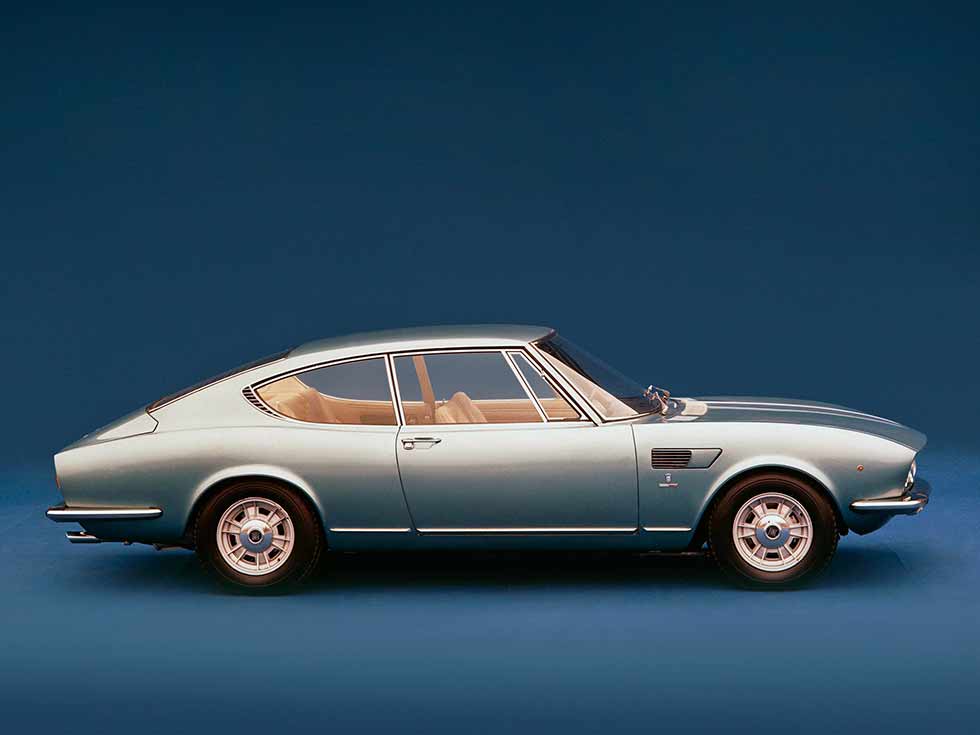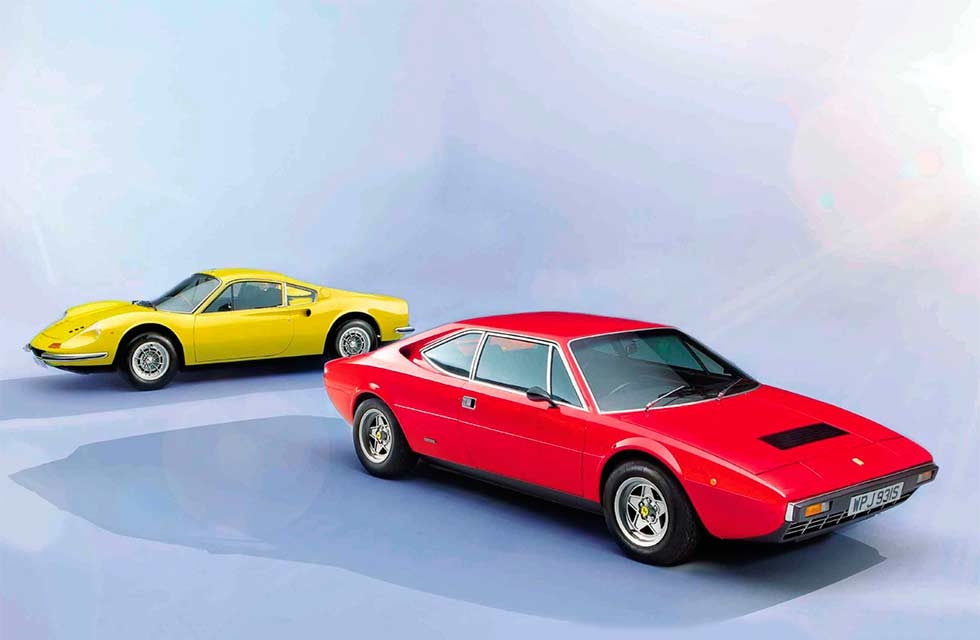
Baby Boomers. Ferrari’s original 1960s baby has become a high-value mainstay on every collector’s wishlist. What’s the fate of its arguably better but more angular 1970s successor? Drive-My investigates. Words Robert Coucher. Photography Matthew Howell.
FERRARI DINO – THE CARS – THE MAN – THE LEGEND
The market’s booming for Ferrari’s babies, but can the sharp-edged 308GT4 ever match the curvaceous Dino 246GT?
The first run on the investment classic car market came to a sudden end following the Wall Street stock market crash in October 1987. The collector car boom, which crashed two years later in 1989, was led by speculators, and Ferrari – the most highly sought after marque – was at the forefront of this ignominious fall in values, with million-dollar Daytonas reduced to around $100,000.

But in the intervening years, the classic car market has staged a recovery and once again collector cars are trading for ever higher prices as valueless cash is being invested in safe tangibles… such as Ferraris.
But there are Ferraris, and then there are Ferraris, as with the two Dinos you see here. One is valued at about 30 grand and the other nearer a quarter of a million!
Interestingly, just prior to the 1989 market peak, neither the ‘affordable’ Dino 246GT nor the 308GT4 were perceived as being top-flight collector Ferraris. In fact 246GT values peaked at about £90,000 then slumped back to half that after the crash. The 308GT4 was not even rated. These Ferraris were badged Dino (the 308GT4 receiving a proper Ferrari badge after 1976) and, with their V6 and V8 engines, were not regarded as proper Maranello muscle. Those had stonking great V12s up front!
But markets and fashions shift. While the 308GT4 remains priced as a nice classic car, Dino 246GT and targa-topped GTS values have gone ballistic and a 246 is now one of the fastest-appreciating classic cars there is. Collectors today rate the Dino 246 as one of Ferrari’s best; consequently prices are galloping onwards and upwards.
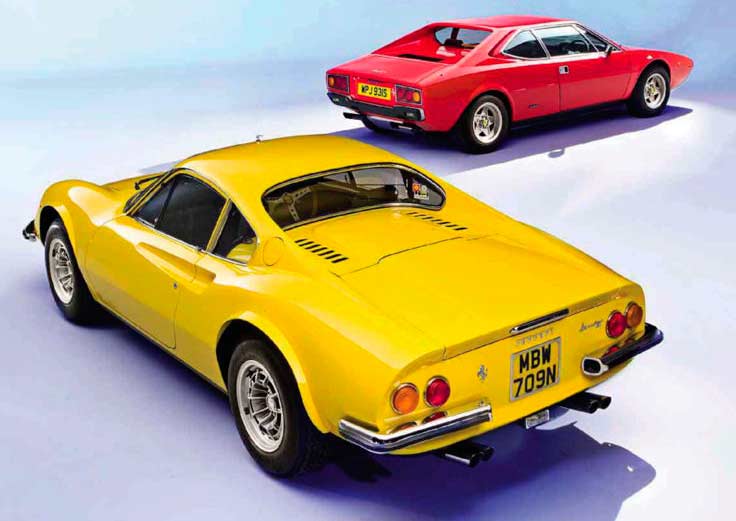
And the 308GT4? The ugly duckling continues to languish at the bottom end of classic Ferrari valuation and there does not seem to be any reason why its value might increase significantly in the foreseeable future.
Yet only 30 years ago the 246 was regarded as a cute piece of shrapnel in a similar vein…
Sergio Pininfarina was commissioned to build a ‘Dino’ concept car for Ferrari, which was first seen at the 1965 Paris motor show. This concept was further refined and shown at the Turin motor show a year later as the Dino 206GT. Production of the Dino began in 1968, Ferrari’s first relatively low-cost sports car. The Dino used Ferrari’s competition car naming designation of displacement and cylinder count, ie 2.0-litre six-cylinder.
‘No doubt Ferrari had observed how well Porsche was doing with its 911 and pitched the Dino against it’
The ‘Dino’ label was in honour of Enzo Ferrari’s son Alfredo ‘Dino’ Ferrari, who died tragically young in 1956. Reports on his involvement with actual Ferrari engineering projects vary, though he was reputedly a gifted engineer. (You can read more about Dino Ferrari on next page)
In total some 2732 Dino 206/246GTs were manufactured plus 1180 GTS versions, the highest production number of any Ferrari model to that date, which moved the company up to another level. No longer just a specialist manufacturer of racing cars and expensive sports cars, Ferrari had joined the big time.
Fiat took control in 1969, which allowed Enzo to concentrate on racing. The Dino name was used on the Fiat Dino Spider and Fiat Dino Coupe, further broadening the brand.
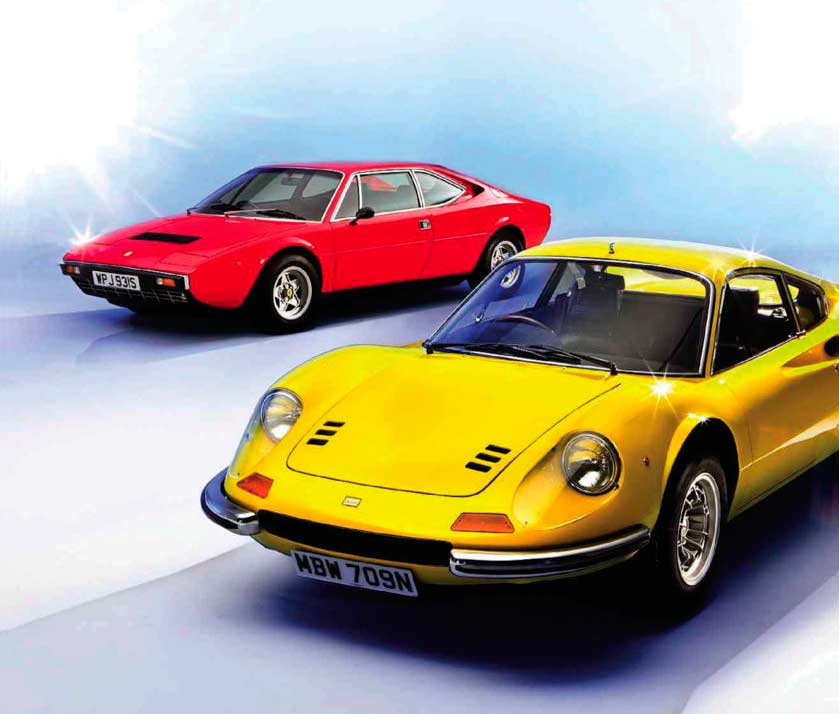
No doubt Ferrari had observed how well Porsche was doing with its 911 and pitched the £5500 Dino directly into this affordable sports car market. Just 157 all-aluminium 206GT examples were manufactured in 1968 and ’69 before the bigger-displacement, all-steel 246GT arrived. This upped the power from 160bhp at a heady 8000rpm to 195bhp at a still revvy 7500rpm, but with 30ft lb more torque. With 0-60mph in seven seconds and a top speed of 143mph, it was faster than the equivalent 911 and not that much more expensive.
Although 246s were produced in high numbers for a Ferrari, they were some of the most beautiful and accomplished sports cars from Maranello. Today, Ferrari aficionados will want a perfect Dino in their collection as it is a Pininfarina masterpiece and a great drive. The 1973 246GT you see here, finished in fetching Giallo Fly, belongs to Leoma Allawi and is now a very desirable example.
‘The 308GT4 is a car very much of its period: sharp and distinctive and a proper Ferrari’
And as with anything collectable, there are certain specific types that are especially sought after. Tony Willis, Ferrari consultant and the man who looks after Ferrari Classiche UK, suggests that with Dinos, ‘the absolute choice model is the all-aluminium, outside filler cap 206GT, in the same way that a flat-floor E-type is the most coveted Jaguar model. This is the purist’s choice.’
But the driver’s choice is this one: the 2.4-litre ‘chairs and flares’ car. Ferrari produced a limited run of Dinos with wider 7.5in sand- cast Campagnolo alloy wheels and flared wings to accommodate them. Inside they received Ferrari Daytona seat inserts, and the example photographed here is one of only 12 right-hand drive 246GTs of that ilk. A further five were imported into the UK according to Willis, who also manages the Maranello Concessionaires Archive.
‘Some don’t entirely appreciate the flares,’ say Willis, ‘suggesting they spoil the Dino’s original purity of line.’ But the chunky alloys add real presence and those seats raise the game in the cockpit. The bottom line is that they are far more valuable than a regular Dino.
‘Last year a beautiful “chairs and flares” Dino sold for around £250,000,’ says Willis, ‘and I know of a number that went for around £225,000, all perfectly restored cars. It had been difficult to find the original plastic trim material so an original interior is really prized. But the black and beige plastic is becoming available again and some cars were ordered with the leather option from new. In the UK, the open GTS models are slightly more sought- after than the GT but many regard the GT as the nicer car,’ he adds.
Nice is an understatement. The Dino is pure, curvaceous automotive seduction as only Pininfarina can manage. The low and lithe shape suggests responsiveness and precision but without recourse to sharp and brutal straight lines or functionalism.
The Dino is an exquisite-looking sports car, now regarded as one of Ferrari’s best ever. Interestingly, though created in the 1960s, the Dino is bang-on modern sports car thinking and design. The age of lumbering unwieldy sports cars is over, with all manufacturers going for light weight and manageable size. Ferrari’s own 458 Italia has been on a diet, the new 911 is lighter than the previous model, and the McLaren MP4-12C is the future.
The Dino 246GT weights 1080kg and will do almost 150mph – which is just fine for a classic car. It looks diminutive in the metal but promises to be more enjoyable to drive on real roads than, say, a large V12 Daytona. Delicacy abounds as you open the small driver’s door via a tiny chrome catch. The cockpit is low-slung but airy and the reclined ‘chair’ does without rake adjustment. Your feet are well offset to the centreline, as is the steering wheel, and the view over the Veglia- stuffed instrument binnacle is through the high-arching front wings.
You need to dab the throttle and pump some fuel into the three twin-choke Weber carbs, then twist the key. The little V6 fires with a loud roar as the chain-driven double overhead cam engine clears its throats with enthusiasm. The clutch is firm and short-travel and the trademark thin chrome gearlever requires a shove to engage first gear, out on a dog-leg.
Visibility is good and the steering improves with speed. Riding on 205 / 70×14 XWX Michelins, the ride flows on the all-wishbone, coil-sprung suspension. The engine and gearbox astern are mounted well within the wheelbase, which shows up as speed rises. Initially the steering seems slow and the promise of understeer looms, but then the front end bites and it scythes through bends with precision. All the while that race-derived V6 is going for the redline with verve and just listening to the noise makes you hang onto the revs just a tad longer, before the next upshift.
The gearshift, with its exposed gate, remains a bit recalcitrant and you have to match it to the revs, but the Dino’s chassis is faithful and the brakes are positive, which all flatters the drive. All you really want is more power!
Ferrari specialist and historic racing driver James Cottingham loves the Dino. ‘It really is one of the most rewarding Ferraris to drive even if it is not the fastest. And just look at it! It’s no wonder we can’t find enough good examples to sell,’ he says.
And that’s the killer point: the looks. Some question how Ferrari could replace the voluptuous, curvaceous and gorgeous 246 with Bertone’s hard-edged 308GT4. Maybe it harks back to 1968 when Ferrari’s Daytona was criticised as being plain vanilla in comparison with Lamborghini’s Miura of the same year – the car that coined the supercar appellation.
Bertone designer Marcello Gandini had to package a 2+2 configuration onto the 246 chassis, so that was lengthened and the V8 engine had to remain amidships. This quad- cam V8 in 3.0-litre guise added a useful increase in power and torque but it also weighs 200kg more than the 246.
But look at the 308GT4 today and, while not conventionally pretty, it works in a very 1970s fashion. Its crisp, clean lines are understated and it has good proportions and shape. With thin pillars and a large glass area, it is considerably more modem than the 246 and has the advantage of two rear seats and more interior space. Porsche must have given it a close look; Ferrari shifted 3000, making the 308GT4 one of its best sellers.
Like the other James Bond car, the Lotus Esprit S1 – admittedly overshadowed by the earlier and curvier Aston DB5 – the 308GT4 is a car very much of its period and today looks damn interesting. It is sharp and distinctive and it is a proper Ferrari – well, certainly since the ‘Ferrari’ badge replaced ‘Dino’ from 1976.
‘The 308GT4 is an excellent road car,’ says James Cottingham. ‘It is just so versatile. It has plenty of space and luggage room and you can get two normal-sized people in the back seats. Best of all the chassis is really good, as is the ride, and the V8’s added grunt means it is really fun to drive hard.’
Tony Willis concurs. ‘When I was working at Maranello Concessionaires the 308GT4 was the car of the day so I spent a lot of time driving them. It handles better than a 246 Dino and is much more practical. I used to borrow one off the forecourt, stick numbers on the side and take it hillclimbing,’ he laughs.
‘The 308GT4 is a bit of a sleeper although the best examples are now approaching £50,000. You want a later Ferrari-badged car with bigger wheels and a better resolved interior.’
This 1979 Rosso Corsa example with black leather seats has a great history file and that important Ferrari badge on the bonnet. Having covered just 60,000 miles it has been lightly restored and looks superb.
Fire it up and the lusty V8 is loud through the four exhaust snaps although, being a flat- plane crank arrangement, it does not sound like a lazy Detroit V8. This one fizzes and zings in proper Maranello style. The clutch is sturdy and the gearlever moves through the typical open gate, as with the 246. On the move the 308GT4 is a peach because visibility is so good and the bigger engine offers a useful amount of torque so you don’t actually have to wang through the gears… unless you want to.
The brakes are reassuring and the steering is a little slower due to the longer wheelbase, but the ride is a revelation. Like the 246 it’s shod with 70-series tyres; it feels unusually pliant yet retains that Ferrari sharpness and razor response. The 308GT4 is a great driver’s car.
Both the 246GT and the 308GT4 are fabulous sports cars. They offer true Ferrari dynamics and are a real pleasure to drive. But a Dino 246 commands about six times the value of a Ferrari 308GT4. Is it worth it? Yes it is, because that’s what the market has decided. The Pininfarina Dino is much better-looking than the Bertone Dino and that is what every Ferrari collector wants. But, while this gorgeous 246GT will always remain a Dino, this 308GT4 will always be a Ferrari…
THANKS TO Leoma Allawi for the 246GT, and DK Engineering for the 308GT4, www.dkeng.com.
TECHNICAL DATA FILE SPECIFICATIONS 1973 DINO 246GT
ENGINE 2418cc V6, DOHC perbank, three-twin-choke downdraught Weber 40DCNF carburettors
MAX POWER 195bhp @ 7600rpm
MAX TORQUE 166lb ft @ 5500 rpm
TRANSMISSION Five-speed manual, rear-wheel drive
STEERING Rack and pinion
SUSPENSION Front and rear: unequal wishbones, coil springs, telescopic dampers, anti-roll bar
BRAKES Discs
WEIGHT 1077kg
PERFORMANCE Top speed 143mph. 0-60mph 7.0sec
TECHNICAL DATA FILE SPECIFICATIONS 1979 FERRARI DINO 308GT4
ENGINE 2927cc V8, DOHC perbank, four-twin-choke downdraught Weber 40DCNF carburettors
MAX POWER 250bhp @ 7700rpm
MAX TORQUE 210lb ft @ 5000rpm
TRANSMISSION Five-speed manual, rear-wheel drive
STEERING Rackand pinion
SUSPENSION Front and rear: unequal wishbones, coil springs, telescopic dampers, anti-roll bar
BRAKES Vented discs servo-assisted
WEIGHT 1285kg
PERFORMANCE Top speed 152mph. 0-60mph 6.4sec
Above: It’s a late car so it wears the Ferrari badge. Interior is calm, ordered – and has space for four. Left and above That shovel nose looks more than just a single generation on from the 246GT; 250bhp V8 plays 195bhp V6. Left: The Daytona-style seat inserts mark out this particular Dino; it’s pretty dark and plain in here, nonetheless. Above: Classical meets modernist: Dino 2A6GT is all curves and dainty chrome detailing – which Bertone’s 308GTA eschews. Left and above This ‘chairs and flares’ Dino is especially collectable; like all its ilk, it’s powered by a quad-cam V6.
CURVED OR STRAIGHT?
Stephen Bayley ponders whether the 308GT4 will ever be prized above the 246for the way it looks
The imagination is always drawn to the miniature: the suggestions of jewel-like intensity and skill in execution are pleasing. Meanwhile, curves short-circuit consciousness, sending strong messages directly to the pleasure centre of the brain. Ask a Freudian. Curves make a primal association with sex and fertility. These are just two reasons why the Dino 246 is one of the most beautiful of all cars.
This exquisite little Ferrari is Pininfarina at its High Renaissance. The 246’s predecessors were not always so perfectly resolved, while its successors tended towards a look-at-me mannerism of a sometimes too obvious sort.
At the same time, while the mid-engine layout is ergonomically preposterous, it allows designers to work with perfect aesthetic proportions. Pininfarina did not neglect to exploit the opportunity. Perfection exists not when there is nothing to add, but when nothing needs to be taken away. Here is perfect form, proportion and detail.
Will we ever feel so strongly about the 246’s successor, the razor-edged 308 by Bertone? That’s a question of taste, and even the cautious get cut-off by taste’s unpredictable tides. What’s certain is that we have, in the aesthetic contrast of the 246 and the 308, a juxtaposition familiar in art. The fluid versus the solid; the organic versus the mechanical; the romantic versus classic; the painterly versus the graphic.
Or, as a cultural historian would put it: Dionysos versus Apollo. Thing is, Apollo was a bit of bore. Still, one day, the deliriously beautiful 246 might appear maladroit and dated. One day, the stiff-looking 308 may be promoted to the realms of gorgeousness and desire. We may go lush about its hard edges and brittle stance. One day. But not soon. Not, if you ask me, ever.
Below and above Bertone’s 1976 Rainbow prototype, based on a 308GT4 floorpan, showed one direction Ferrari might have gone stylistically; but time has proven that gentlemen still prefer curves, as in Aldo Brovarone’s 1965 sketch for the Dino.
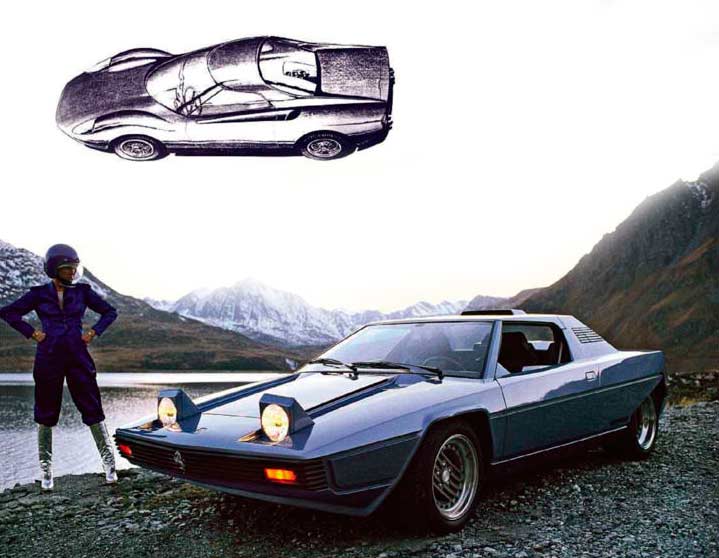
LIVING WITH A DINO
They’re Ferraris, they’re old – so by definition they must be fragile, right?
Not necessarily, according to Dino specialist Nick Cartwright (www.nickcartwright.com), whose company has restored about 75 of the Dino 246, and a few 308GT4s too. ‘Both models are lovely cars to drive, when in good condition – the problem is that there are so many poor ones around, especially 246s.
‘Engines in both are robust, and the V6 has a timing chain rather than belts – as long as you check valve clearances and chain tension regularly, it doesn’t give trouble. A 12,000-mile major service is £1250-1500 plus VAT.
‘The V8 has belts but if you do them as part of an 18,000-mile service, the total is £1000 plus VAT. The 308 is mechanically strong and, if anything, slightly less expensive to run than a 246. With the latter, it’s crucial to warm it gently from cold, for the sake of the gearbox in particular.
‘Neither car had much in the way of rust protection and my first Dino in 1974 was already rotten! But the spares situation is better than it ever has been, thanks to companies such as Superformance and Eurospares.’
DINO THE MAN
His life was short, but Alfredo ‘Dino’ Ferrari was given a form of immortality by his grieving father
Whatever your opinion of Enzo Ferrari – and he certainly wasn’t the easiest of people to work with – you’d need a heart of stone not to feel desperately sorry for the loss he suffered on 30 June 1956, when his beloved son Dino died of kidney failure. Dino was only 24 years old and had been afflicted by an inherited form of muscular dystrophy since he was 20.
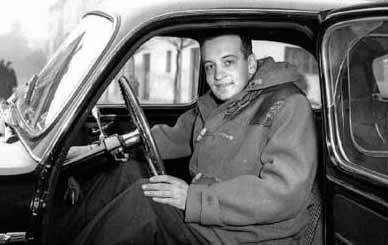
It’s said that Enzo wore a black tie for years afterwards as a symbol of mourning. But he gave Dino immortality of a kind by naming a new range of V6 racing engines after him and, in due course, a sub-brand of Ferrari road cars that were intended to take on Porsche’s 911. The Dino script that appears on these cars is based on his son’s signature.
Enzo always intended that his son, born to his wife Laura on 19 January 1932 and christened Alfredo – the name ‘Dino’ is a contraction of Alfredino, the familiar form of Alfredo – would take over the family business. Dino showed no early promise as a driver, and it was decided that he should concentrate on his engineering studies instead (the photo, below, shows Dino on the left, with Enzo and two mechanics, working on a V12 engine in late 1953). For his degree at Modena’s Corni Institute he produced a thesis on a twin-overhead-cam 1500cc inline four with three valves per cylinder, and he went on to study for a second degree at Fribourg in Switzerland. He seems to have been well-liked as a student, helping colleagues to buy books and technical magazines if they needed them.
How much Dino achieved at Ferrari is hard to say, for there wasn’t much clear water between his university studies and the rapid onset of the disease that killed him. It’s said that he worked on the body design for his own personal 166MM, and that this form was applied to racing versions of the Monza 500 and 750 in 1954.
The extent of his involvement with the V6 engine series that would later bear his name is similarly obscure. Designed to meet the 1500cc limit of 1957’s new Formula 2, the V6 was mostly the work of former Lancia engineer Vittorio Jano and ex-Alfa and Maserati man Alberto Massimino. It’s been suggested that the initial idea for the engine came from Dino – but was this a story perpetuated by the factory to add lustre to his posthumous reputation?
Only a few years ago, there were rumours – incorrect, as it turned out – that the forthcoming 458 would carry the Dino name. Dino may be long gone, but he’s certainly not forgotten.
THANKS TO Matthias Bartz for the photos. Matthias’s superb book on the Dino 206 and 246, the Dino Compendium, is available from www.dino-book.com.
THE ‘OTHER’ DINOS
There were many more Dinos besides the 246 and 308GT4 – for both road and track
COMPETITION CARS
A big variety of V6-powered Dino race cars were made from 1957 onwards, starting with the 156 F2 car and moving into F1 with the 246 Dino (above) in which Peter Collins was killed during the 1958 German GP. The Dino V6 also went into numerous sports-racers, beginning with 1958’s Dino 206.
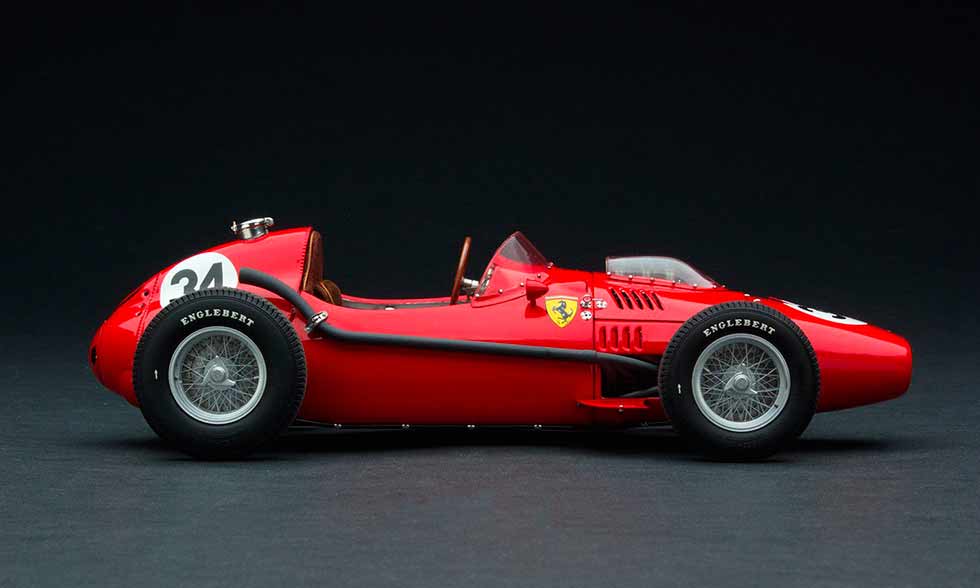
DINO BERLINETTA SPECIALE
Pininfarina’s first attempt at making a Dino in the metal was shown in Paris in 1965, the Brovarone reworking of a Fioravanti Fiat-Abarth spider proposal. Being built on a Type 585 tubular frame meant wide sills and difficult access, but it led to Enzo greenlighting the Dino road car project.

DINO COMPETIZIONE
Pininfarina stylist Paolo Martin sketched the 1967 Dino Berlinetta Competizione when he was just 23 although the ugly front and rear spoilers were added at management’s insistence to make the car look more ‘racy’. A huge glass area and gullwing doors are features of this drivable styling study.
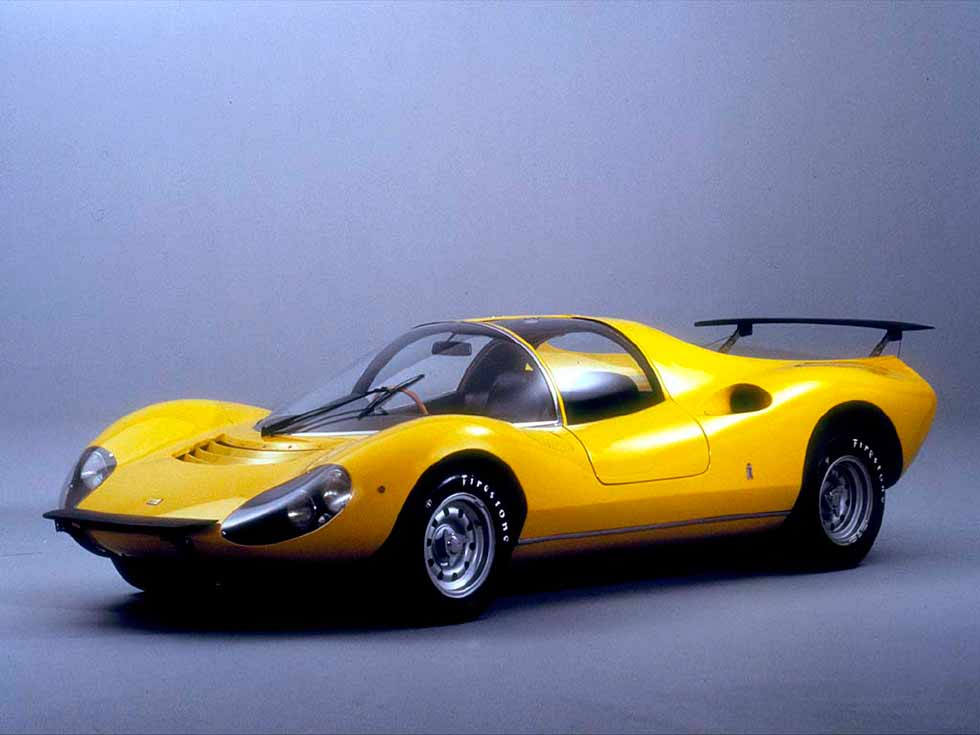
FIAT DINO COUPE
Fiat’s Dino Spider and Coupe used V6 engines similar to the 206 and 246 Dinos’; 2.0-litre from 1966 and 2.4-litre from 1969. Oddly, the Spider was styled by Pininfarina, the Coupe by Bertone. The 2.4 cars were built at Maranello, alongside the 246s; about 7800 of all types were made until 1973.
